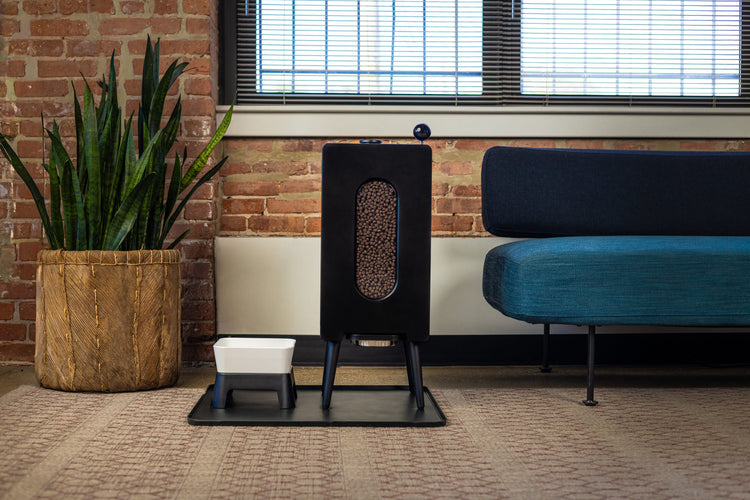How Often to Feed 6 Week Old Puppy: A Guide to Optimal Nutrition and Care
- Houndsy
Table of Contents
- Introduction
- Understanding the Nutritional Needs of a 6 Week Old Puppy
- How Often to Feed 6 Week Old Puppy: Recommended Feeding Schedule
- Feeding Tips for a Smooth 6 Week Puppy Diet Transition
- Simplifying Puppy Feeding with Houndsy
- Common Challenges and How to Overcome Them
- Reflecting on Your Puppy’s Feeding Routine
- Conclusion
Introduction
Imagine welcoming a tiny, curious 6-week-old puppy into your home—a bundle of joy and energy, but also a delicate little being relying entirely on your care. At this critical stage, how often to feed a 6 week old puppy is not just a casual question—it’s central to ensuring their healthy growth, proper development, and long-term well-being. Feeding frequency and quality set the foundation for puppy health, impacting everything from energy levels and immune function to behavior and digestion.
The transition from mother’s milk to solid food is a nuanced process packed with both excitement and challenges for new pet parents. This pivotal period requires thoughtful attention to nutrition, portion control, and routine. This comprehensive guide will walk you through the important factors in determining feeding frequency, suggest practical schedules, dive into nutritional needs, and provide expert insights to help you foster a happy, healthy puppy.
If you’ve ever wondered, “how often should I feed my 6 week old puppy?” you’re in the right place. Together, we’ll unravel the steps, understand why consistency matters, and learn how to simplify feeding without sacrificing quality—even introducing you to innovations like the Houndsy Kibble Dispenser that elevate your daily routine. Let’s dive in and give your puppy the absolute best start possible.
Understanding the Nutritional Needs of a 6 Week Old Puppy
The Transition from Mom’s Milk to Solid Food
At 6 weeks old, puppies are in a delicate developmental phase called the socialization period—where their senses become sharper, social skills emerge, and, crucially, they begin shifting from exclusive milk feeding to solid food. Mother’s milk has provided essential nutrients and immunity through colostrum during the neonatal stage, but from around 4 weeks onward, puppies start nibbling on softened solid foods to complement milking.
This transition is not instantaneous. Puppies need food that is easy to digest, rich in protein, fats, and essential micronutrients to support rapid growth. For 6-week-old pups, a high-quality puppy formula or kibble softened into a porridge-like consistency is often recommended. Remember, puppies' stomachs are still small and sensitive—so frequent, small meals help prevent digestive upset and hypoglycemia (low blood sugar).
Why Feeding Frequency is So Important at 6 Weeks
Puppies grow extremely fast at this age, with their metabolism working overtime to build muscle, bones, and organs. Small stomach volume, combined with high energy demands, means they cannot hold large meals comfortably and need food spread out across the day.
Feeding too infrequently can lead to weakness, lethargy, or hypoglycemia—especially in toy or small breeds prone to blood sugar dips. Conversely, feeding too much at once may cause digestive upset or choking hazards.
A well-planned feeding schedule ensures:
- Steady energy and nutrient supply
- Healthy weight gain
- Optimal digestion and nutrient absorption
- Development of positive feeding habits
- Establishment of a consistent daily routine that aids training
Key Nutritional Components for 6 Week Old Puppies
- Protein: Foundational for muscle and tissue development. Puppy formulas feature higher protein than adult dog food.
- Fat: Concentrated energy source vital for rapid growth and brain development.
- Calcium and Phosphorus: Essential minerals for bone growth; ratios need careful balance, especially in large breeds.
- Vitamins and Antioxidants: Support immune health and organ development.
- Water: Critical for hydration, especially as puppies start eating drier food.
Choosing a complete, balanced puppy food that meets AAFCO (Association of American Feed Control Officials) standards is crucial. Avoid homemade or adult food substitutions without vet consultation, as puppies’ needs differ significantly during this early stage.
How Often to Feed 6 Week Old Puppy: Recommended Feeding Schedule
General Feeding Frequency Guidelines
For a 6 week old puppy, the current veterinary consensus, supported by multiple expert sources, recommends feeding approximately 4 times a day. This ensures that your puppy sustains energy levels, maintains stable blood sugar, and supports consistent growth without overloading their small digestive system.
Typical 6 Week Feeding Schedule Example:
| Meal Time | Feeding Notes |
|---|---|
| 7:00 AM (Breakfast) | Small portion, softened kibble |
| 12:00 PM (Lunch) | Small portion, encourage gentle eating |
| 4:00 PM (Afternoon Snack) | Small portion, monitor appetite |
| 7:00 PM (Dinner) | Smallest meal to avoid overnight hunger |
This schedule also supports developing a routine that aids house training and behavior management. Feeding at consistent times helps puppies associate mealtime as a positive event.
Breed and Size Considerations
- Toy and Small Breeds: Might require 4 to 5 meals a day due to higher metabolism and risk of hypoglycemia.
- Medium to Large Breeds: Typically 3 to 4 meals a day, but some large breeds benefit from more frequent smaller meals to prevent bloat—a dangerous stomach condition.
Smaller meals more frequently are preferable to fewer large meals to reduce digestive stress and ensure consistent nutrient supply tailored to the breed's metabolic rate.
Quantity: How Much to Feed?
Feeding amounts will depend on the puppy’s weight, breed, and chosen food formula. Puppy food packaging often provides feeding charts that are a helpful baseline, but individual variation exists.
A practical approach is to divide the total recommended daily amount into four equal portions, gradually adjusting portions based on observation of weight gain and stool quality.
Monitoring Your Puppy’s Response
- Is the puppy gaining weight steadily? (Expected: roughly 5-10% daily increase)
- Are stool and digestion normal? (Avoid diarrhea or constipation)
- Is the puppy energetic and alert after meals?
Regular check-ins help you tweak quantity and frequency, and working with your vet ensures optimal growth monitoring.
Feeding Tips for a Smooth 6 Week Puppy Diet Transition
Start with Softened Kibble or Puppy Porridge
To ease the transition from milk, soak high-quality dry puppy food in warm water or puppy milk replacer until it softens to a porridge or gruel-like texture. This is easier to chew and digest.
Avoid Sudden Food Changes
Puppies have sensitive stomachs. Abrupt changes in food type can cause vomiting or diarrhea. Gradually decrease milk replacer and increase solid food over 1–2 weeks.
Maintain Strict Hygiene
At this age, their immune systems are developing. Always provide fresh water and clean bowls. Feeding tools like the elegantly designed Houndsy Kibble Dispenser keep food fresh with its BPA-free liner and help prevent contamination.
Prevent Overeating and Food Stealing
Keep puppies fed in separate bowls or areas to ensure each puppy gets their share and avoid conflict or overeating.
Simplifying Puppy Feeding with Houndsy
Feeding multiple small meals daily can be overwhelming for busy pet parents. That’s where Houndsy steps in to elevate your feeding ritual.
Our flagship Houndsy Kibble Dispenser is designed to provide consistent perfect portions with the simple turn of an ergonomic crank—no more bending or messy scooping. It stores 25-30 lbs of kibble fresh and safe, with an auto-locking mechanism keeping curious paws out.
Not only does it bring unmatched convenience, but its mid-century modern design adds a touch of style to your home. Feeding your 6 week old puppy (and later, adult dog) becomes a seamless, enjoyable part of your day, leaving more time for play and cuddles.
Curious how this product can transform your puppy feeding routine? Explore the Houndsy Kibble Dispenser here.
Common Challenges and How to Overcome Them
Puppy Refusing Food
If your puppy is hesitant to eat solid food, try warming it slightly or mixing in a bit of puppy milk replacer. Patience and persistence are key—offer food at regular intervals and avoid free feeding at this stage to encourage appetite.
Accidental Overfeeding and Obesity
Avoid leaving food out all day to prevent overeating and obesity later in life. Feeding measured portions multiple times a day helps regulate intake.
Food Allergies or Sensitivities
Some puppies may show intolerance to specific ingredients. Monitor for signs like diarrhea, vomiting, or itching and consult your vet if these appear. A high-quality puppy food with limited ingredients may help.
Reflecting on Your Puppy’s Feeding Routine
- Does your current feeding schedule align with the 4-meal plan ideal for a 6 week old puppy?
- Have you considered the breed-specific needs in portion size and feeding frequency?
- Are you leveraging tools or products that make feeding easier and more consistent for you?
Considering these questions can help optimize your puppy’s health outcomes and your daily routine efficiency.
Conclusion
Understanding how often to feed a 6 week old puppy is a foundational step in providing exceptional care that supports their rapid growth and development. Four small meals daily, consisting of high-quality softened puppy food, supply steady nutrients without overwhelming their tiny digestive systems. This careful balance helps prevent hypoglycemia, digestive issues, and encourages healthy weight gain.
Feeding at consistent intervals also promotes behavioral discipline and aids life skills like house training—setting the stage for a well-adjusted adult dog. The transition from milk to solids is a dance of patience, gradual introduction, and quality nutrition.
To make this process enjoyable and practical for you, the Houndsy Kibble Dispenser offers an elegant, reliable solution that aligns perfectly with your puppy’s dietary needs and your lifestyle. With Houndsy, the feeding ritual becomes a moment of care and connection — beautifully designed to make everyday easier and more joyful.
Why not take the next step in elevating your feeding routine? Check out the Houndsy Kibble Dispenser today and transform how you nurture your new best friend.
FAQ: How Often to Feed 6 Week Old Puppy
Q1: Can I feed my 6 week old puppy fewer than 4 times a day?
It’s generally recommended to feed 4 times a day at this age because of their small stomachs and high energy demands. Feeding less frequently may lead to hypoglycemia or hunger stress. Once the puppy is older and their stomach capacity increases, feeding frequency can be reduced.
Q2: What if my puppy refuses to eat solid food?
Try softening the food with warm water or puppy milk replacer. Sometimes warming the food slightly can entice eating. Ensure feedings occur in a quiet, calm area without distractions. Consult your vet if refusals persist.
Q3: Is it safe to switch straight from milk replacer to dry kibble at 6 weeks?
No. The transition should be gradual over 1–2 weeks, mixing softened kibble or porridge with milk replacer to allow your puppy’s digestive system to adjust comfortably.
Q4: How do I know how much food to give each meal?
Refer to the puppy food manufacturer’s feeding chart as a baseline and divide the total daily amount into four equal meals. Monitor your puppy’s weight and overall health to fine-tune portions over time.
Q5: Can I use the Houndsy Kibble Dispenser for puppy feeding?
Absolutely! The Houndsy Kibble Dispenser helps you measure consistent portions effortlessly and can store large quantities of kibble fresh and secure, making your feeding routine more convenient and stylish.
Q6: What if I have multiple puppies to feed?
Feed puppies separately in their own dishes to ensure each gets the correct portion. The Houndsy Kibble Dispenser can be a helpful tool in dispensing perfect portions quickly, especially when handling multiple meals per day.
Q7: When should I transition from puppy food to adult dog food?
Most puppies transition to adult food around 12 months of age or when they've reached approximately 80% of their expected adult size. Large breed puppies may take longer, sometimes up to 18-24 months. Consult your vet for breed-specific advice.
Proper feeding is the cornerstone of your puppy’s healthy future. Embrace the journey with confidence, care, and the right tools tailored to your lifestyle and your puppy’s needs. Discover how the Houndsy Kibble Dispenser can become an essential part of your feeding routine today.












